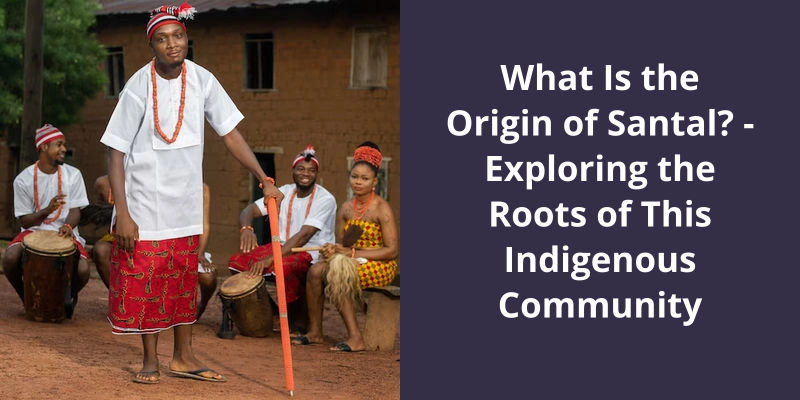The Santal, also known as the Santali, is an indigenous community that originated in the Indian subcontinent. Most documented history traces back the Santal people to the regions around West Bengal, Jharkhand, Odisha and Bihar in India. They are considered to be one of the largest tribal communities in India. Their language, called Santali, is part of the Austroasiatic language family. Over centuries, the Santal community has been recognized for maintaining their unique cultural traditions, including music, dance, and craft, despite various external influences.

What Is the Ethnic Originity of Santal?
They’ve their own unique culture, language, customs and beliefs which have been preserved for centuries. The Santal community has a rich history and traces back their origin to the prehistoric times. According to the traditions of the community, they’ve spent their early times in the region which is now known as Vietnam, Cambodia and Laos. The community migrated to India around 4,000 years ago and have been living here ever since.
The people of the Santal tribe are known for their simplicity and resilience. They’ve a deep connection with nature and their way of life revolves around it. The Santals are predominantly farmers and practice subsistence agriculture. However, with changing times, many Santals have also adopted alternate professions like handicrafts making, carpentry, construction, and labour work.
The Santal people are known for their intricate cultural practices and traditions. Their festivals are celebrated with a lot of fervour and involve singing, dancing and feasting. The most famous festivals of the Santal community are Baha, Sohrae, and Karam. These festivals celebrate the bountiful harvest, thanksgiving to nature, and the worship of their gods and goddesses.
The Santal community has a rich tradition of art and crafts. They’re famous for their intricate dokhra art, which involves the casting of metal. The Santal people are also known for their woodcarving, which is done by skilled craftsmen who create beautiful figurines, toys, and decorative pieces. The community has also been instrumental in preserving the traditional dance forms like the Sohrai dance and the Jatra dance.
Despite being a large and thriving community, the Santal people have faced a lot of persecution over the years. They’ve been subjected to land grabbing, forced displacement, and discrimination. However, the community has always shown remarkable resilience and has fought to preserve their identity and way of life. Today, the Santal community is a proud and thriving one, known for their diversity, culture, and strength.
The religion of the Santals is a rich blend of traditional beliefs and Christianity, reflecting the complex history and culture of this indigenous group in Bangladesh. While maintaining their traditional customs and practices, they’ve also adopted aspects of Christianity as part of their religious and cultural identity. In this article, we will explore the fascinating and vibrant world of Santal religion and it’s role in shaping the community’s identity and way of life.
What Is the Religion of Santal in Bangladesh?
Their traditional religion, however, is animistic and revolves around the belief that all living and non-living things have spirits and are interconnected. The Santals believe in a supreme deity, Thakur Jiu, who’s responsible for creation and sustenance, and several other gods and goddesses who oversee different aspects of life such as agriculture, hunting, and health.
The Santals view the world as a balance between good and evil, and strive to maintain harmony with nature and their surroundings. They practice various rituals and ceremonies throughout the year, such as the Karam festival which celebrates the harvest season and the Baha festival which honors the departed ancestors. These ceremonies often involve singing, dancing, and offerings to the spirits and deities.
Despite the influence of Christianity and Islam on the Santals in Bangladesh, many aspects of their traditional religion have been preserved and continue to be practiced today. The Santals have a strong connection to their ancestral land, and their religion reflects this deep respect for nature and the environment. They see themselves as custodians of the earth and work to ensure that it isn’t exploited or abused.
The Santal religion also has a strong social aspect, with community members coming together for collective worship and to resolve conflicts. The role of the village headman, or gosain, is important in maintaining social harmony and mediating disputes. The Santals also have a rich oral tradition, with myths, legends, and folktales passed down through generations.
Source: Santal people
The Santal tribe in India has a rich and diverse oral tradition that includes various forms of literature and art such as folktales, myths, riddles, village stories, songs, and traditional dance. However, with the passing of time, much of this valuable cultural heritage has been recorded or written down, which has helped to ensure it’s preservation for future generations to appreciate and cherish. Let’s delve deeper into the fascinating world of Santal tradition and explore it’s unique features and significance.
What Is the Tradition of Santal?
The Santal people are an indigenous group hailing from East India, Bangladesh, and Nepal, with a population of over 6 million. The Santal have a unique set of cultural practices, guided by their oral traditions, which have been passed down through the generations. These practices have helped to shape their way of life, their relations with other communities, and their overall identity.
Folktales, myths, riddles, and village stories are all part of their rich oral history. These stories are meant to convey important cultural values and knowledge, and are often accompanied by song and dance. In recent times, many of these stories have been recorded or written down to preserve their cultural heritage for future generations.
Traditional songs and dances are also an integral part of the Santal culture. Every type of song is accompanied by a particular type of dance, and each dance has it’s own unique style and choreography. These songs and dances are often performed during community events, social gatherings and religious ceremonies, where they serve as a form of cultural expression and entertainment.
Religion is also an essential part of Santal culture. The Santal people typically practice traditional animistic beliefs, where they worship local spirits and deities. Their religious practices are based on the belief that every element of nature is alive and must be treated with respect. They believe that their actions can have a direct impact on the environment and strive to live in harmony with nature.
Another unique feature of Santal culture is their social structure. Despite living in modern times, the Santal people still adhere to a strict hierarchical system based on age and gender. Elders are highly respected and hold a significant position in the community, while women are responsible for managing the household and taking care of children. However, younger members of the community are working to challenge these traditional norms and promote greater gender equality.
Their traditions emphasize the importance of song and dance, the significance of nature, and the value of social hierarchies. These traditions have helped to shape their way of life and have been passed down through the generations, providing a unique insight into their cultural identity.
But physical characteristics can only tell us so much about a group of people. To truly understand the Santals, we must delve deeper into their culture and way of life.
What Are the Physical Characteristics of the Santals?
The Santals are one of the oldest and largest indigenous tribes in India. They’ve a distinctive physical appearance that sets them apart from other ethnic groups residing in the country. Most Santals have a flat nose, which is a prominent feature of their faces. Additionally, they’ve long heads, which are often referred to as dolichocephalic. The shape of their heads is thought to be a result of cultural practices such as head wrapping or head binding.
Aside from their facial features, the Santals also exhibit a unique skin color. Most of them have a brownish hue that sets them apart from other regional groups. Additionally, their body proportions tend to be different. Santals are known for having a shorter stature and a more muscular build than other ethnicities. They also typically have broad shoulders and well-defined jawlines.
Despite their distinct physical features, the Santals lead a very simple life. They’re generally a rural and agricultural-based community, living close to the land and nature. They’ve their own language, which is known as Santali, and is written using the Ol Chiki script. The Santals are also known for their cultural heritage, which includes dance, music, and various art forms.
The Santals are predominantly concentrated in the east-central Indian states of West Bengal, Odisha, Jharkhand, and Bihar. They’re an endogamous society, meaning that they tend to marry within their own community. Their traditional occupations include agriculture, metalworking, and basket weaving. The Santals have a strong connection to their ancestral land and often hold forest and land rights in the areas where they reside.
Conclusion
While historical records indicate that their original homeland may have been in present-day northern Cambodia, their migration into India through Assam and Bengal has played a significant role in shaping their culture and traditions. Through their deeply-rooted traditions and practices, the Santals continue to preserve their unique identity and remain an integral part of India's diverse cultural fabric.




